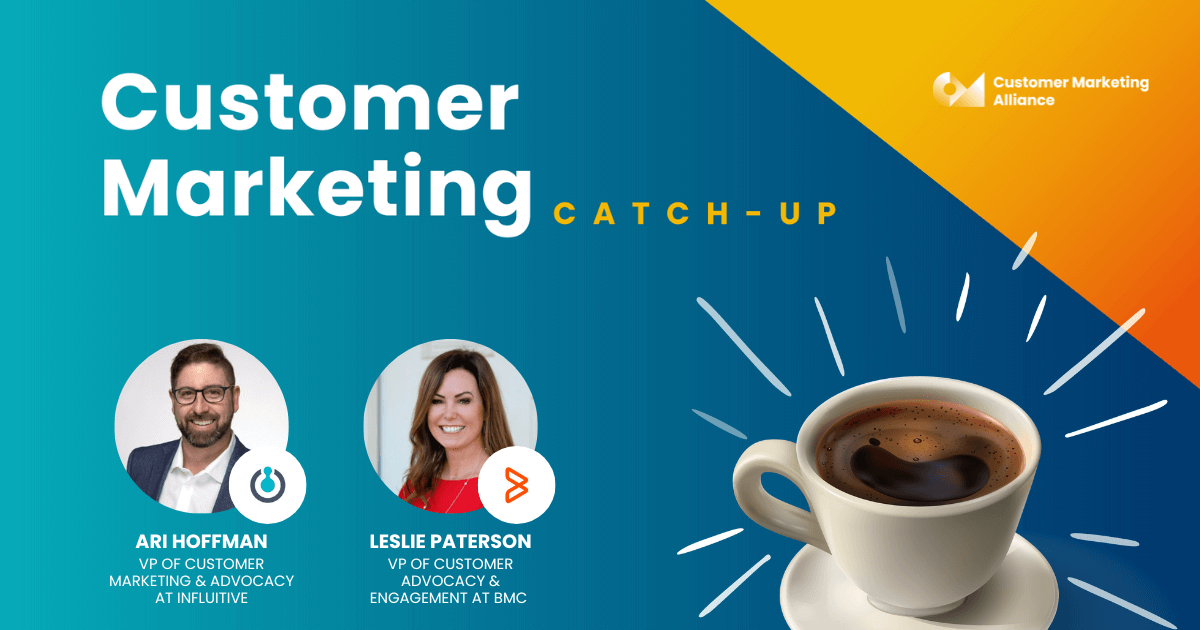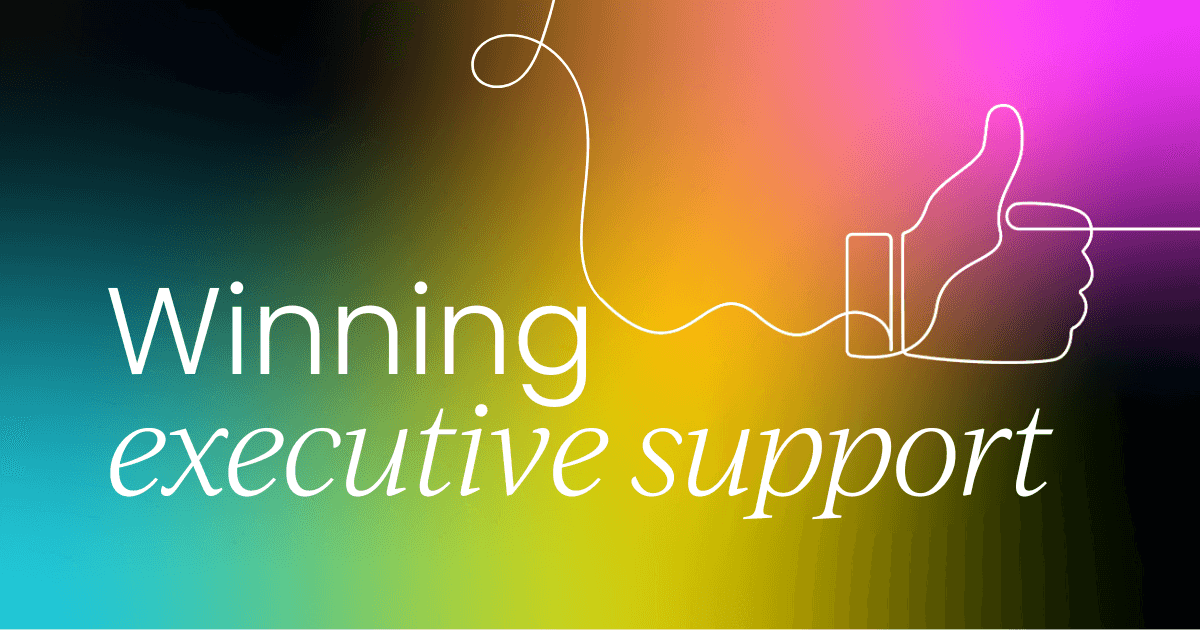Successful customer advocacy starts with strong internal alignment.
Years of leading programs at BMC, Genesys, and Oracle has taught me the importance of listening first, building with intention, and connecting advocacy efforts to what matters most to the business.
If you’re building a new team or evolving an existing one, here’s what I’ve learned works best.

Start by listening, not telling
I’ve learned this the hard way, having approached advocacy program launches both the wrong way and, thankfully, what I now believe to be the right way.
One of the most essential lessons I’ve taken from those experiences is the importance of establishing a two-way dialogue with executive stakeholders. And in those early conversations, that dialogue needs to be heavily weighted toward listening.
It can be tempting to walk in with a clear vision and a fully formed playbook for what a successful advocacy program should look like – especially if you’ve done this before.
But the truth is, every organization is different. Executive stakeholders each have their own definitions of success. What’s a win for one might not even register as a priority for another. That’s why asking, listening, and understanding what “good” looks like to each stakeholder is absolutely foundational.
I always ask: “If an advocacy program was ideal for you and your team, what would it deliver?” That open-ended question reveals so much. But you have to be patient enough to absorb the answers without jumping in to prove you’ve already done it elsewhere.
Surprise and delight them later, listen now.
Build champions by solving their problems first
If you don’t take the time to understand what each executive actually wants, you risk working in a silo. That’s when you start hearing the dreaded, “So, what do you do again?” – a clear sign you’ve failed to connect your work to what matters to them.
What you want is to build champions out of your stakeholders. And that only happens when you solve their problems. If you listen well, they’ll tell you exactly what they need – often without you even having to ask directly.
Once they see you delivering against their goals, they’ll trust you to run with the rest.
That trust is what gives you the freedom to start building out the broader program – the things you know will elevate advocacy. But first, earn their confidence by aligning with their priorities.
Make the case for advocacy through efficiency, economy, and impact
Thankfully, I don’t have to spend as much time anymore explaining why advocacy matters – executive teams and boards are increasingly seeing its value.
But for anyone still needing to make that case, I always recommend framing it around three pillars: efficiency, economy, and impact.
- Efficiency
Designing the team in a way that a single request – say, for a speaker at an event – can be fulfilled quickly through a well-connected network of advocates.
For example, I’ve always advocated for embedding customer engagement directors in regional markets to maintain close relationships with key customers. That proximity allows us to respond rapidly and confidently to requests.
- Economy
This is about scale. Those engagement directors need the ability to build and manage strong relationships with 30 to 40 customers each. That’s no small feat – it takes poise, experience, and exceptional organization. But with the right people, you can cover your global advocacy needs with a lean, focused team.
- Impact
Where it all comes together. You need to articulate exactly how advocacy contributes to business goals. Whether it's influenced bookings, faster deal cycles, or improved retention, the data must tell the story.
Our most engaged advocates stay with us longer, deepen their relationships, and bring in others. When you can tie those outcomes to dashboards and forecasts, your value becomes undeniable.
Don't chase your tail: Focus on business value
Here’s something I say to my team all the time (probably too often): Don’t chase your tail. It’s easy to fall into the trap of focusing on output – 30 case studies, 10 videos, and so on.
But if those assets don’t support our strategic goals or move the needle with prospects, we’re wasting effort and budget.
I’d much rather have five powerful, relatable stories that we can repurpose effectively than dozens of mediocre ones. Every story should be an asset, not just content for content’s sake.
Advocate for your people, too
Another point that often gets overlooked is the impact of team structure on employee retention. If you don’t staff your advocacy team appropriately, if you put too much on one person, you burn them out.
I’ve seen it again and again – unrealistic expectations, lack of ownership, and eventually, high turnover.
When structured right, these teams take pressure off of other departments too – particularly customer success. That’s a powerful internal stat you can surface to show cross-functional value.
Just as you focus on customer advocacy, you need to advocate internally for the resources, support, and structure your team needs to thrive.
Measurement is strategic, not tactical
Measurement isn’t about checking boxes or hitting quotas. It’s not “30 stories” or “X number of reviews.” That kind of tactical mindset will keep you stuck in execution mode, rather than being seen as a strategic contributor.
Instead, frame metrics around business impact. Are we shortening deal cycles? Increasing conversion rates? Influencing renewal decisions? These are the questions that resonate at the executive level.
To answer them well, you have to start by asking your stakeholders what success looks like for them. Then, build programs that support those metrics. When you align your outputs with their KPIs, you earn a seat at the table.
Mapping the business needs to your advocacy plan
One of the best ways to prioritize and defend your roadmap is to bucket initiatives by business need. Are you solving for brand? Sales acceleration? Expansion? Adoption?
This model lets you say “yes, and” instead of “no” when new requests arise.
For example, when someone asks for something outside your current priority, you can say: “Great – that’s in our third bucket. Right now, we’re focused on bucket one. Do you recommend we shift priorities, or queue this for later?” It’s collaborative, respectful, and protects your team’s bandwidth.
And it creates a natural path to request more headcount when demand begins to outstrip supply.
Paving the path for the next generation
I’ve been in this space for a long time, and I’ve earned my fair share of skinned knees along the way. At this point in my career, my biggest motivation is to pave a smoother path for those just starting out.
If you’re building your first team or transitioning into an advocacy role, I want you to know: it doesn’t have to be that hard. If you start by listening, align with the business, and focus on real impact, this work will pay off. I promise.
Securing support and building the team
Once I’ve had those foundational conversations with executives and understand their priorities, I move quickly to secure their active support.
If I sense alignment during those talks, I don’t leave it at a handshake. I’ll ask directly: “Can I count on your support as I build this team?” That could be in the form of feedback, advocacy to other stakeholders, or simply helping reinforce the program’s importance internally.
That step is key. It tells you who your allies are – and those allies make all the difference. Their buy-in makes the headcount and budget conversations smoother because you’re no longer just “another person asking for more.” You're someone with a plan that aligns with leadership’s goals.
Once that support is secured, headcount is the very next priority. This work cannot be done alone. I’ve seen too many talented people burn out trying to run advocacy programs solo. You need a team that’s matched to the work ahead and aligned with the right skill sets.
And once you have that, the creativity can flourish – you’re free to get innovative with how advocates are engaged, how stories are told, and how different internal teams contribute to those stories.
For instance, at Genesys, we partnered closely with our value consulting team to identify customers who deeply understood and could articulate the value of the solution. That made our job easier. These weren’t just happy customers – they were informed, articulate, and ready to advocate with clarity and conviction.
Partnerships like that allow you to build smarter, not just harder.
The first steps to building a high-impact team
If your executives have given you the green light and said, “We trust you – go build it,” the first thing you need to do is understand what the business needs. Not what you think they need – what they’ve said they need.
Does the business want to improve brand visibility? Shorten sales cycles? Increase executive participation at events? Grow peer reviews before BDRs reach out? Each of those goals requires a different program structure and different early deliverables.
That’s why I love the six-month mark as a target window. By then, you know your team, your product, and your internal landscape well enough to deliver something meaningful. If you can launch programs that show results by then – especially results that tie directly to executive goals – you’ve created a flywheel for advocacy to keep growing.
When executive support wavers
Sometimes, despite the best early conversations, things change. Priorities shift, relationships drift, or access to stakeholders becomes more limited. I used to feel discouraged when that happened – now, I view it as a cue to reframe the conversation.
What I’ve found incredibly effective is presenting a “current state vs. future state” story. Current state acknowledges wins and challenges honestly. Future state presents a clear, strategic vision for what’s possible, especially when it's informed by what I know those stakeholders care about.
It’s important to pair this with a visual. Conversations fade, but visuals stick. If you can show them what the program could achieve, not just tell them, you have a far better chance of reconnecting and re-engaging their interest.
Don’t let setbacks derail the bigger mission
I’ve been in situations where executive support dropped off or advocacy was deprioritized. It can feel isolating. You might start wondering if all the work you’ve done is about to unravel. But that doesn’t mean it’s time to quit or abandon the mission. Often, it just means it’s time to pivot.
Find new pathways. Rebuild connections. And, if needed, give it some breathing room before making your next move. This work matters too much to give up because of a temporary shift.
Impact is in the numbers and the stories
When I talk about “articulating impact,” I don’t mean flooding a slide with logos. That’s table stakes. What I’m talking about is real business impact – the kind that makes a sales or finance leader sit up and say, “That’s what I care about.”
To do that, you need data – and allies who can help you access and visualize that data. At BMC and in my previous roles, we worked to tie our customer engagements directly to Salesforce opportunity IDs. With the right dashboards (I love Tableau because it’s simple enough that even I can use it), we could show:
- Which advocacy interactions occurred
- What happened in pipeline afterward (new opportunities, expansions, accelerations)
- And how those shifts tied back to specific programs like customer advisory boards or executive councils
That’s the kind of data nobody can argue with, especially when it’s their numbers. And when you pair those numbers with stories that are specific, personal, and aligned with their strategic goals? That’s when the lightbulb really switches on.
Build credibility from the ground up
Sometimes, you’re not going to have direct access to key decision-makers right away. That’s okay. You can still build trust and visibility through their direct reports. At a previous company, when I needed buy-in from a CRO I barely knew, I focused on making sure his team was aware of and benefitting from my work. Slowly, word got back to him.
Eventually, when the time was right, I reached out and asked the most important question: “What does a successful program look like to you?”
He flipped it on me: “You tell me.”
And I was ready. I’d already workshopped my story with my CMO, refined my message, and clarified my vision. That’s when I shared my “advocacy well” analogy – a framework for how our program would work and grow. I didn’t need to walk through every single detail. I just needed to show that I had a roadmap, a vision, and a plan for how to get there.
Your map, their milestones
Executives don’t need to know about every twist and turn. But they do need to know you’re driving toward a destination that matters – to them, to the business, and to customers. That’s what strategy is all about: a clear current state, a compelling future state, and a credible path to get from here to there.
Why internal advocacy matters as much as customer advocacy
As someone who lives and breathes customer advocacy, of course I believe it’s critical. But beyond personal bias, I’ve seen time and time again how transformational it can be – when the organization understands and supports it.
That’s why having executives advocate for your advocacy program is one of the most powerful accelerants to success. If your ELT is talking about the impact of your work, it trickles down fast.
I’ve seen my calendar fill up almost overnight with people across the business saying, “Hey, I want to connect. I want to support what you’re doing.” When I ask how they heard about us, it’s often because a senior leader mentioned our program.
That’s what organizational buy-in looks like. But to sustain it, you also need to set realistic goals. Define what you’ll deliver in three, six, nine, and 12 months. It’s not just about hitting milestones – it’s about protecting your team from burnout and showing respect for the scale of the work.
When your team members become the longest-standing relationships a customer has, outlasting even multiple account managers, that’s real advocacy in action.
Ask for advice, not opinions
Here’s a small but powerful mindset shift I’ve learned: when building internal champions, don’t ask for opinions, ask for advice. Advice creates connection. It pulls the other person into your journey. They want to see you succeed because their name is now tied to your success, even subconsciously.
Once you take their advice, follow up. Show them how it helped, what changed, what results it led to. That’s how you bring executives and peers into your corner – and keep them there.
Keep growing your circle of advocates internally
Even if you already have a successful program, don’t get complacent. Keep looking for new allies across the executive team. At Genesys, we started pulling in execs who weren’t part of our original circle (like our CFO) for customer-facing activities like roundtables.
He was a little hesitant at first, but the experience was exceptional. And from then on, it was an immediate yes anytime we asked him to get involved.
Bringing new voices into the program not only strengthens it, but helps sustain it over time. Advocacy isn’t just something you scale externally – it’s something you scale internally too.
Mapping the business needs to your advocacy plan
One of the best ways to prioritize and defend your roadmap is to bucket initiatives by business need. Are you solving for brand? Sales acceleration? Expansion? Adoption?
This model lets you say “yes, and” instead of “no” when new requests arise. For example, when someone asks for something outside your current priority, you can say: “Great – that’s in our third bucket. Right now, we’re focused on bucket one. Do you recommend we shift priorities, or queue this for later?” It’s collaborative, respectful, and protects your team’s bandwidth.
And – bonus – it creates a natural path to request more headcount when demand begins to outstrip supply.
A story of executive alignment that made all the difference
I’ll end with a recent example. When I was in early discussions with my current CMO about the need for an advocacy program, I made one thing very clear – even after three or four conversations: this does not happen with just me. If I’m doing this, I need a team.
Because we had those prior conversations and built alignment around the vision, when it came time to talk about resources, it wasn’t a battle. He saw the value, and he trusted the direction. That clarity from the start allowed us to build the team to the size needed to deliver real impact – and we’ve been moving forward with confidence ever since.
People, tools, and vision
Yes, you need the right people in place. Yes, you need the right tools – whether it’s an advocacy hub, a scheduling platform for briefings, or systems to automate reporting. But above all, you need the ability to clearly articulate why you’re doing what you’re doing.
That means setting the stage with executives, listening to what matters most to them, tying your work to measurable outcomes, and telling the story behind the data. That’s how you turn internal curiosity into commitment – and build something that lasts.
This article was based on Leslie's appearance on the Customer Marketing Catch-up podcast. You can listen to the full episode here.


 12 min read
12 min read
 Follow us on LinkedIn
Follow us on LinkedIn




